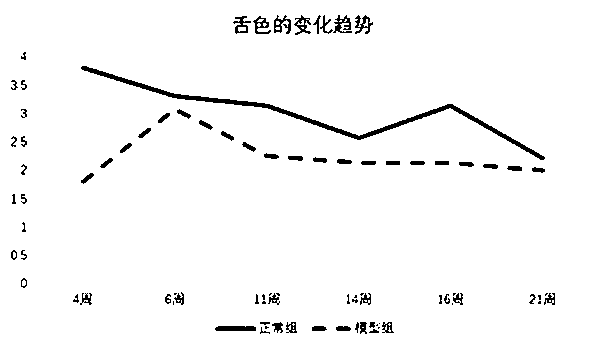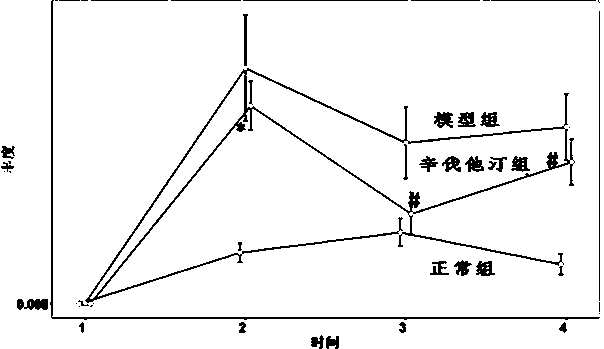Animal model construction method for study of spleen deficiency and dampness syndrome and application thereof
A technology of spleen deficiency and dampness, animal model, applied in the field of biomedicine, to achieve the effects of simple modeling method, good practicability, easy operation and promotion
- Summary
- Abstract
- Description
- Claims
- Application Information
AI Technical Summary
Problems solved by technology
Method used
Image
Examples
Embodiment 1
[0029] Example 1: Construction of a rat model in stagnation and damp-heat syndrome stages
[0030] (1) Animal grouping and feeding: 100 SPF grade male SD rats, weighing 160±20g, provided by the Experimental Animal Science and Technology Center of Jiangxi University of Traditional Chinese Medicine [SCXK (Gan) 2018-0003]. Animal feeding conditions: natural lighting according to circadian rhythm, rearing in SPF level experimental animal barrier system, laboratory temperature 23±2°C, relative humidity 53±3%. After a week of adaptive feeding, the animals were randomly divided into a model group (90 rats) and a normal group (10 rats), and they were fed with a high-fat diet (60% fat content) and a normal basic maintenance diet (10% fat content, respectively). quantity).
[0031] (2) Feed:
[0032] The normal basic maintenance feed ingredients are: choline chloride 0.2%, corn 30%, wheat 25.5%, honey yeast 2.5%, calcium hydrogen phosphate 2%, stone powder 1%, growth premix 1%, salt 0.3...
Embodiment 2
[0041] Example 2: Construction of Rat Models in Stages of Spleen Deficiency and Stasis Syndrome
[0042] (1) Animal grouping and feeding: the normal group (10 rats) in Example 1 and the rats in the model group (73 rats) conforming to stagnation and damp-heat syndrome continued to be fed in the SPF-level experimental animal barrier system in Example 1, At this stage, the two groups of animals were placed in 2 independent experimental rooms for feeding. The rats in the normal group (10) were fed under the same conditions as in Example 1, and continued to feed the normal basic maintenance feed (10% fat content), while the model Rats in the group (73 rats) were fed with a high-fat diet (60% fat content) by raising the relative humidity to 90±3%.
[0043] (2) Detection of indicators: Same as Example 1.
[0044] (3) Rats with spleen deficiency and blood stasis syndrome: Combining some clinical characteristics of rats with the diagnostic criteria of human spleen deficiency, it is de...
Embodiment 3
[0055] Example 3: Application of Rat Model of Spleen Deficiency and Excessive Dampness Syndrome
[0056] The first is to combine some clinical characteristics of spleen-deficiency rats with the diagnostic criteria of human spleen-deficiency to determine that the rats have abdominal obesity, loss of appetite, loose stool, dark yellow urine, purple tongue or watery coating. , fatigue, fatigue, drowsiness, hair loss, squinting and other symptoms and signs to assist in the diagnosis of depression, damp heat, spleen deficiency and blood stasis syndrome in humans. Further, in the study on the syndrome of spleen deficiency and dampness, the characteristics of intestinal bacteria Akkermansia ( AKK ) abundance and the ratio of kynurenine to tryptophan increased to assist in the diagnosis of human spleen deficiency and blood stasis syndrome. Further, in the study of spleen deficiency and dampness syndrome, after intervening the model with simvastatin and rosiglitazone in the positive...
PUM
 Login to View More
Login to View More Abstract
Description
Claims
Application Information
 Login to View More
Login to View More - R&D
- Intellectual Property
- Life Sciences
- Materials
- Tech Scout
- Unparalleled Data Quality
- Higher Quality Content
- 60% Fewer Hallucinations
Browse by: Latest US Patents, China's latest patents, Technical Efficacy Thesaurus, Application Domain, Technology Topic, Popular Technical Reports.
© 2025 PatSnap. All rights reserved.Legal|Privacy policy|Modern Slavery Act Transparency Statement|Sitemap|About US| Contact US: help@patsnap.com



